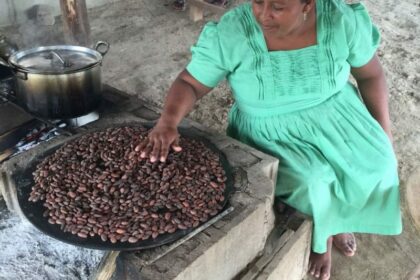Haiti is a tropical paradise where babies can be seen flying through crowded streets at fast speeds on motorbikes held tightly in the arms of their guardians. There are so many pressing needs in Haiti, the poorest country in the western hemisphere, public safety hasn’t yet made the list.
On a recent visit to Cap-Haitian, I took a closer look at the overwhelming problem of malnutrition in Haiti (nearly 50% of the population is undernourished) through the eyes of Second Mile Haiti, a nonprofit organization founded by two Americans, Jenn Schenk and Amy Syres, who first met in this northern part of Haiti while doing orphanage work in 2011.
One of the things Schenk and Syres noticed while working at the orphanage was how Plumpy’Nut, a ready-to-use therapeutic food invented in France in 1996 to treat severe acute malnutrition in young children, had a tendency to create a culture of reliance on a special hand-out to make life better.
To counter this kind of short-term thinking, Second Mile Haiti placed education and mentoring at the heart of their work. Their rural program site—reached after driving down a muddy, unpaved road—has milking cows, goats, chickens, a huge vegetable garden, and very few non-Haitians in sight.
While severely malnourished children are rehabilitated by Plumpy’Nut (which is now made locally in Haiti by Meds & Food for Kids and in eight other countries worldwide) caregivers (mothers, aunties, grandmothers) at Second Mile are taught how to care for their sick and malnourished child in a setting that is not so different than their own home. They live on-site four nights a week in a basic room with a simple bed, a polished cement floor that can be swept easily, and a large pink mosquito net.
Re-learning self-reliance and problem solving is central to Second Mile Haiti’s model. While in the program, caregivers are given responsibilities to make them feel more invested. Throughout their stay, while their children are monitored daily by on-site Haitian nurses, women attend Haitian-run classes in literacy, nutrition, hygiene, gardening, and starting a new business. Once the children are healthy, the women go back home, often with veggies in their arms, more skilled and empowered to create a healthier future for their entire families.
The roots of malnutrition in Haiti are complex Syres, a registered nurse, shared with me. Lack of knowledge about nutritious food choices compounds the lack of diverse food choices in poor households in Haiti. Nutritional deficiencies may be worsened by recurrent parasitic infections, common in tropical climates, or an imbalance of gut flora; topics that Syres follows closely as she helps evolve Second Mile Haiti’s programming.
We saw the possible outcome of a nutritional deficiency while at Second Mile: a malnourished child with hydrocephalus, whose brain was stretched to its maximum by fluid. It’s something extremely painful for the child that is rarely seen so visibly in the United States. There’s only one hospital in Port-au-Prince that performs the necessary operation to help children with this birth defect, which is not easily accessible from Cap-Haitian. In these cases, Second Mile Haiti helps pay for caregivers to get to where they need to go. It’s just another way that they help create a public safety net in a country that has so few.
Get Involved
To help take action to end childhood malnutrition in Haiti and other developing countries around the world, check out these ways to help:
Sign and share:
A petition to reduce all child deaths from malnutrition
Read and share:
12 Facts You Might Not Know About Acute Malnutrition
Learn:
Acute Malnutrition: An Everyday Emergency – A 10-point plan for tackling malnutrition in under-fives
Support:
Large humanitarian organizations that are helping treat children with acute malnutrition in Haiti and globally:
Small grassroots organizations that are helping treat children with acute malnutrition in Haiti:
Nonprofit factories that make Plumpy’Nut® and other ready-to-use foods to target malnutrition:
*All photos courtesy of Second Mile Haiti
About The Author
Heidi Reed is the Communications Manager at Edesia, a non-profit organization and food manufacturer in Providence, Rhode Island, that since March 2010, has helped treat and prevent malnutrition for 2.5 million children in 45 countries.
Also Check Out:
Delicious Ways To Support The Local Economy While Traveling
Grassroots Volunteering: A Guide To Global Good On The Road
How A Farm-To-Fork Food Truck Is Providing A Positive Future For Formerly-Incarcerated Youth
Jessica Festa
Latest posts by Jessica Festa (see all)
- A Culturally-Immersive Adventure In Mongolia’s Altai Mountains - Jul 8, 2023
- This Recipe Sharing Platform Supports Women In The Culinary Industry (Labneh Recipe Included!) - Nov 5, 2020
- Hiking The Mohare Danda Community Eco-Trek In Nepal - Jun 3, 2020
- 6 Important Questions For Choosing A Responsible Yoga Retreat - May 18, 2020
- How To Create & Grow A Profitable Blogging Business (Ethically) - Jan 18, 2020








Haiti is a country I’d love to visit soon. Such a heartbreaking situation but it’s good to know that organizations are running great programs. Looking into the organizations you mentioned!
Haiti is such a beautiful country. There has been a lot of progress rebuilding the country but there’s also a long way to go for self-reliance and overall improvement in infrastructure. I’m really glad to see programs using Haitian staff and personnel to provide care and expertise. I think that’s the key to a self-reliant Haiti.
@Megan: Agreed! I think often giving money isn’t the solution. We need to help build self-reliant communities who can use their own skills and knowledge to prosper.